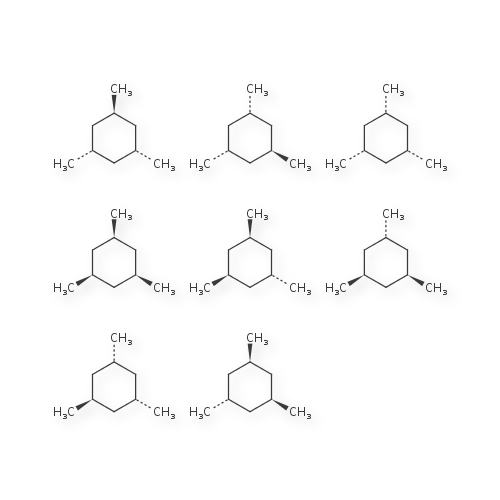You signed in with another tab or window. Reload to refresh your session.You signed out in another tab or window. Reload to refresh your session.You switched accounts on another tab or window. Reload to refresh your session.Dismiss alert
{{ message }}
This repository has been archived by the owner on Jul 10, 2024. It is now read-only.
Some meaningless stereo annotations (wedge/dash bonds) produce different hashes than non-annotated bonds.
Example 1
Compare:
C[C@H]1OC(C)O[C@@H](C)O1
WDF2GBCFX-X5KQLPPFPK-XK7RRPGCCM2-XK25W2RXGM3Z
vs
CC1OC(C)OC(C)O1
WDF2GBCFX-X5KQLPPFPK-XK7RRPGCCM2-XK23BSZ142DG
In this example, there are 3 stereo centers that could be annotated. However, out of the 8 absolute permutations, only 2 are actually unique:
You'll notice that of all 8 possibilities, only 2 are non-degenerate. And in both cases, it must be the case that atleasttwo adjacent methyl groups are on the same side of the ring. So the information provided by the first structure is self-evident.
The InChI algorithm does handle this specific case (possibly by accident), but it does not handle the general issue, as explained in example 2.
Example 2
Compare:
[C@H](C)1CCC(C)CC1
T75RBW5S8-8D9T563A7Y-8YC8NQXD9W5-8Y5APDLVJ782
vs
C(C)1CCC(C)CC1
T75RBW5S8-8D9T563A7Y-8YC8NQXD9W5-8Y5VPCVHUV1Z
Again, these should be equivalent, but currently generate different hashes. For reasons I can't imagine, the two above also generate different InChIs. This is especially odd, considering it's a much simpler case of the general problem explained in example 1.
The text was updated successfully, but these errors were encountered:
Thanks! I'm probably getting carried away with them...
On the resolution of this, one naive solution is to do the following:
Mark all potential non-annotated stereo centers for which R/S is not applicable
Generate canonical hashes for all possible absolute permutations at those centers
Canonically hash the unique set of possible results with current known R/S configurations
Apply this result as the exclusive form of stereochemical encoding in the hash
I believe that would work, in theory ... but a few of the logistics are problematic. Also, there is the potential for a combinatorial explosion in some of these cases. A non-annotated inositol is the worst real case I can think of (with 64 naive permutations), but I'm sure there are worse examples that are still relevent.
Some meaningless stereo annotations (wedge/dash bonds) produce different hashes than non-annotated bonds.
Example 1
Compare:
vs
In this example, there are 3 stereo centers that could be annotated. However, out of the 8 absolute permutations, only 2 are actually unique:

You'll notice that of all 8 possibilities, only 2 are non-degenerate. And in both cases, it must be the case that at least two adjacent methyl groups are on the same side of the ring. So the information provided by the first structure is self-evident.
The InChI algorithm does handle this specific case (possibly by accident), but it does not handle the general issue, as explained in example 2.
Example 2
Compare:
vs
Again, these should be equivalent, but currently generate different hashes. For reasons I can't imagine, the two above also generate different InChIs. This is especially odd, considering it's a much simpler case of the general problem explained in example 1.
The text was updated successfully, but these errors were encountered: